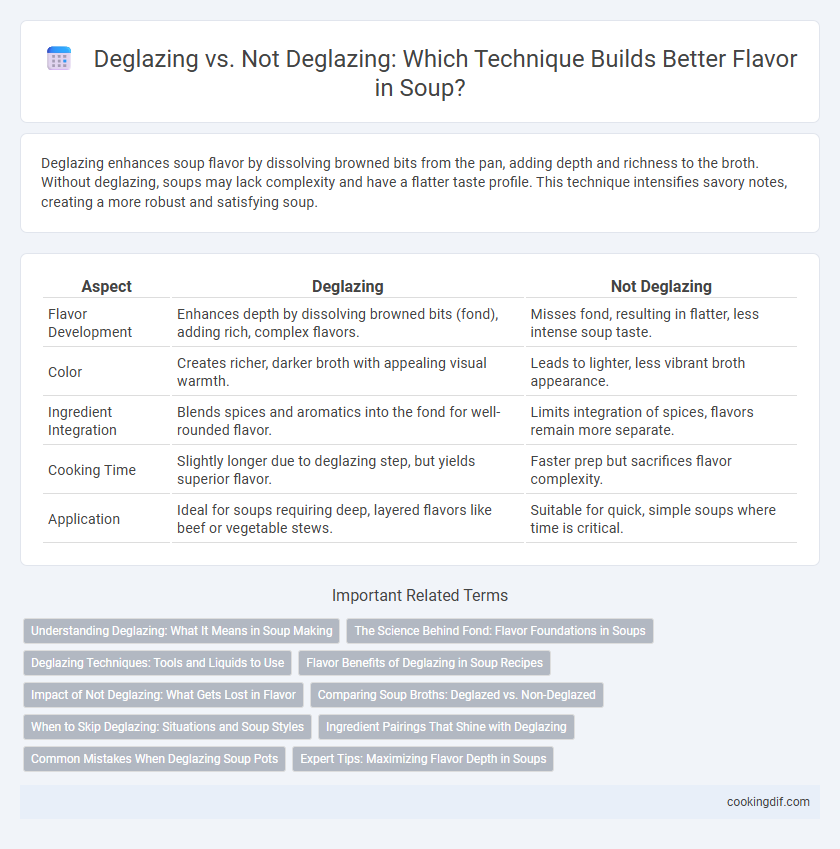Deglazing enhances soup flavor by dissolving browned bits from the pan, adding depth and richness to the broth. Without deglazing, soups may lack complexity and have a flatter taste profile. This technique intensifies savory notes, creating a more robust and satisfying soup.
Table of Comparison
| Aspect | Deglazing | Not Deglazing |
|---|---|---|
| Flavor Development | Enhances depth by dissolving browned bits (fond), adding rich, complex flavors. | Misses fond, resulting in flatter, less intense soup taste. |
| Color | Creates richer, darker broth with appealing visual warmth. | Leads to lighter, less vibrant broth appearance. |
| Ingredient Integration | Blends spices and aromatics into the fond for well-rounded flavor. | Limits integration of spices, flavors remain more separate. |
| Cooking Time | Slightly longer due to deglazing step, but yields superior flavor. | Faster prep but sacrifices flavor complexity. |
| Application | Ideal for soups requiring deep, layered flavors like beef or vegetable stews. | Suitable for quick, simple soups where time is critical. |
Understanding Deglazing: What It Means in Soup Making
Deglazing in soup making involves adding liquid to a hot pan to dissolve browned bits stuck to the bottom, enriching the soup's flavor with deep, caramelized notes. This process captures the essence of sauteed ingredients, intensifying the overall taste profile and enhancing umami complexity. Skipping deglazing may result in a less rich broth, as the flavorful fond remains unincorporated into the soup base.
The Science Behind Fond: Flavor Foundations in Soups
Deglazing dissolves fond, the caramelized bits of protein and sugars stuck to the pan, releasing complex flavors that enhance the soup's depth and richness. Without deglazing, these concentrated flavor compounds remain stuck, resulting in a flatter and less layered taste profile. The Maillard reaction underlying fond formation is crucial for building umami and savory notes essential in gourmet soup bases.
Deglazing Techniques: Tools and Liquids to Use
Deglazing techniques for soup involve using a liquid such as stock, wine, or vinegar to dissolve browned bits left in the pan after sauteing vegetables or meat, unlocking deep, rich flavors essential for flavorful broth. Common tools include stainless steel or cast iron pans that retain fond, and a wooden spoon or whisk to scrape the base effectively without damaging the cookware. Choosing acidic liquids like white wine or apple cider vinegar enhances flavor extraction, while using stock adds depth and continuity to the soup's profile.
Flavor Benefits of Deglazing in Soup Recipes
Deglazing enhances soup flavor by incorporating caramelized bits from the pan, adding depth and richness. This process releases complex Maillard reaction compounds that intensify umami and savory notes in the broth. Soups prepared with deglazing exhibit a more robust and layered taste profile compared to those without.
Impact of Not Deglazing: What Gets Lost in Flavor
Not deglazing a pan after sauteing vegetables or meat for soup results in the loss of flavorful browned bits called fond, which are rich in concentrated umami and caramelized flavors. These bits, when dissolved by deglazing with liquid like wine, broth, or water, infuse the soup with depth and complexity that cannot be achieved otherwise. Skipping this step leads to a flatter, less robust flavor profile, diminishing the overall richness and aroma essential for a well-developed soup.
Comparing Soup Broths: Deglazed vs. Non-Deglazed
Deglazing soup broths enhances flavor depth by incorporating caramelized fond from the cooking vessel, resulting in richer, more complex taste profiles compared to non-deglazed broths. Non-deglazed broths often maintain a cleaner, lighter flavor, which can highlight fresh ingredients but may lack the savory intensity achieved through deglazing. Choosing between deglazing or not directly impacts the umami concentration and overall mouthfeel of the final soup broth.
When to Skip Deglazing: Situations and Soup Styles
Skipping deglazing is beneficial in clear broths or consommes where a clean, delicate flavor profile is essential, as the browned bits may introduce unwanted cloudiness or bitterness. In soups with fresh, subtle ingredients such as vegetable or chicken broth-based recipes, avoiding deglazing preserves the pure, light taste. Deglazing is also unnecessary when using pre-roasted meats or slow-cooked stocks that already contribute deep flavor without additional caramelized residues.
Ingredient Pairings That Shine with Deglazing
Deglazing enhances soups by lifting browned bits from the pan, infusing rich, complex flavors that deepen the overall taste profile. Ingredients like caramelized onions, garlic, and mushrooms pair exceptionally well with deglazing liquids such as wine, sherry, or broth to create savory, umami-rich bases. Using deglazing techniques with herbs like thyme or bay leaves further intensifies aromatic layers, transforming simple stocks into flavorful, well-rounded soups.
Common Mistakes When Deglazing Soup Pots
Deglazing soup pots unlocks rich, caramelized flavors by dissolving browned bits with liquid, but common mistakes include using insufficient liquid, which fails to lift fond properly, and overheating the pan, causing burnt residues that impart bitterness. Avoid pouring cold liquid into a hot pan, as this disrupts flavor extraction and can shock the ingredients. Carefully controlling heat and gradually adding warm broth or wine enhances soup depth without compromising the delicate balance of flavors.
Expert Tips: Maximizing Flavor Depth in Soups
Deglazing the pan with stock or wine after sauteing aromatics captures flavorful fond, intensifying soup depth and complexity. Skipping deglazing can result in a cleaner but less robust broth, lacking those rich caramelized notes. Expert tip: always incorporate the deglazing liquid into the soup base to maximize flavor layers without bitterness.
Deglazing vs Not Deglazing for flavor building Infographic

 cookingdif.com
cookingdif.com